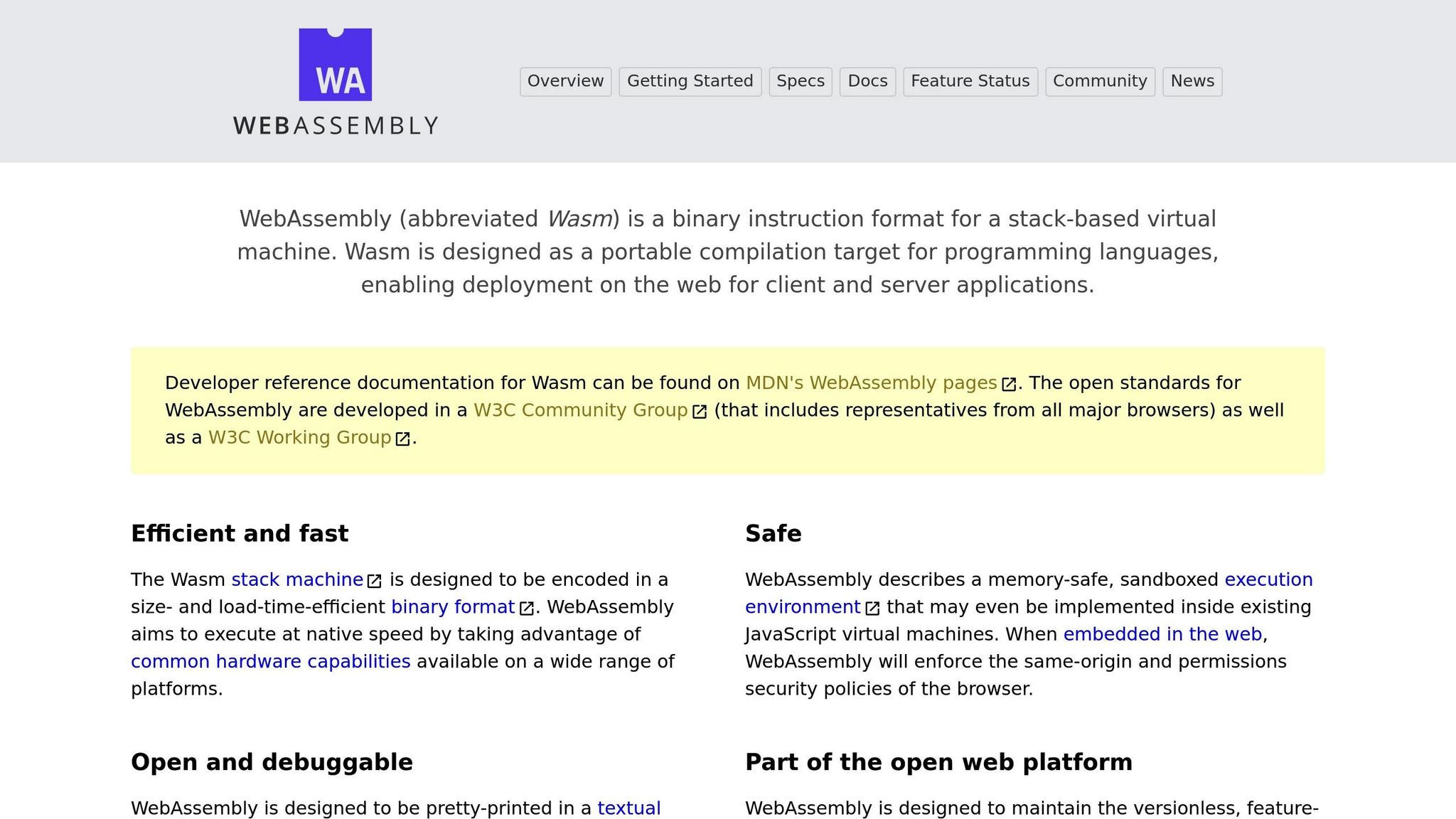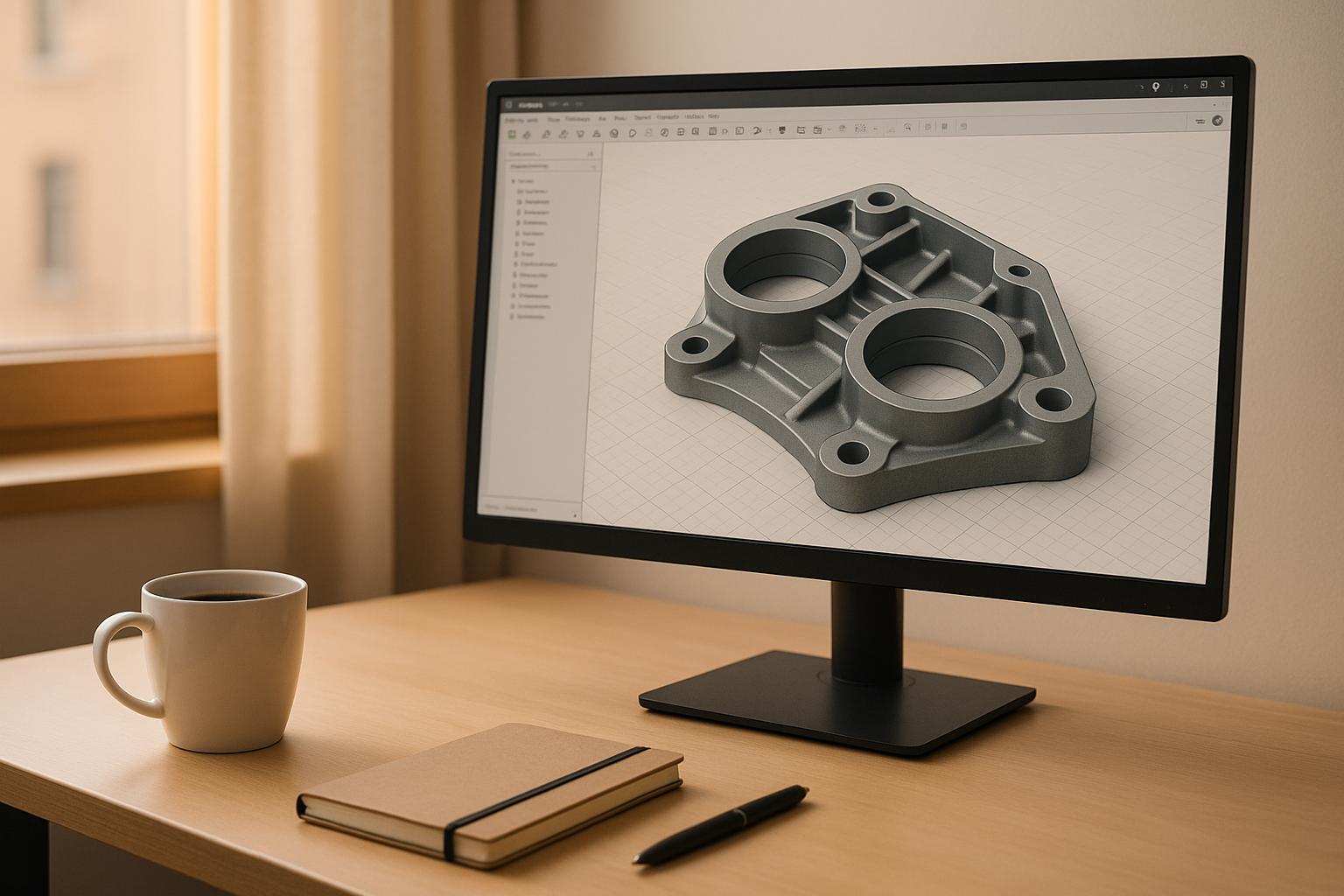WebAssembly (WASM) is transforming browser-based CAD applications by solving performance challenges that JavaScript can’t handle. CAD tools require immense computational power for tasks like real-time 3D rendering, large dataset processing, and geometric calculations. JavaScript struggles with these due to its single-threaded nature, runtime interpretation, and unpredictable garbage collection.
WebAssembly addresses these issues by:
- Running at near-native speeds with precompiled binary code.
- Offering precise memory management without garbage collection delays.
- Allowing developers to reuse C++, Rust, or C code for heavy computations.
- Enabling cross-platform compatibility via universal browser support.
This hybrid approach lets JavaScript handle UI and logic while WASM takes over intensive tasks, ensuring smooth performance. WebAssembly is particularly useful for startups, reducing development time, server costs, and improving user experience. Tools like Emscripten, Rust, and frameworks such as Three.js or OpenCASCADE.js make it easier to integrate WASM into CAD workflows.
Why it matters: WebAssembly is reshaping browser-based CAD, making it faster, scalable, and more accessible – closing the gap with desktop software.
Piotr Głębocki – Rendering 3D graphics in a web browser using WebAssembly

Performance Problems in Browser-Based CAD Tools
Even with WebAssembly addressing some of JavaScript’s shortcomings, browser-based CAD tools still face serious performance hurdles. These tools need to handle massive geometric datasets, execute real-time 3D calculations, and maintain smooth user interactions – all while working within the constraints of JavaScript.
Main JavaScript Bottlenecks for CAD Applications
One major issue is slow interpreted execution. JavaScript’s interpreted nature, combined with Just-In-Time (JIT) compilation, adds runtime overhead, especially during computationally heavy tasks like boolean geometry calculations or mesh generation. These operations can dominate the main thread, causing laggy interfaces and noticeable delays [2].
Another challenge is unpredictable garbage collection. As described by an industry expert:
"Every additional MB adds to the strain, forcing JavaScript’s garbage collector (V8’s Orinoco or SpiderMonkey’s incremental GC) to work overtime, leading to those dreaded performance hiccups."
- Asian Digital Hub [1]
Memory management problems only make things worse. Poor memory handling – such as lingering objects, unnecessary deep copies, and inefficient iterations – can lead to memory spikes or even crashes [1].
Additionally, processing large datasets highlights JavaScript’s inherent limitations. One developer summed it up:
"JavaScript was never designed to handle terabytes of data. Yet, here we are – pushing it to its limits with real-time analytics, AI-driven recommendations, and massive event streams."
- Asian Digital Hub [1]
When industrial CAD files are involved, the consequences are clear:
"The problem? It chokes. Memory spikes. GC (Garbage Collection) pauses. Browser tabs freeze. Servers throw up their hands."
- Asian Digital Hub [1]
These issues collectively push browser-based CAD tools to their limits, negatively affecting user experience.
How Performance Issues Hurt Startup CAD Products
For startups, these performance problems can be especially damaging. Teams often spend significant time optimizing JavaScript instead of focusing on building new features, delaying the launch of minimum viable products (MVPs) [2]. As the codebase grows, load times increase, and performance worsens, creating scalability barriers that restrict product growth [2]. To overcome these challenges, startups need solutions that offer near-native performance. In the next section, we’ll examine how WebAssembly can deliver these benefits.
How WebAssembly Improves CAD Performance
WebAssembly addresses key challenges in computer-aided design (CAD) by delivering faster execution, precise memory management, and smooth integration with existing technologies. These features significantly enhance how browser-based CAD tools manage demanding computational tasks.
WebAssembly’s Near-Native Speed
The precompiled binary format of WebAssembly offers a major speed advantage over JavaScript, which relies on runtime interpretation. Because WebAssembly modules are ready to execute as soon as they load, they eliminate the processing delays that often hinder complex tasks like geometric calculations and 3D rendering.
This speed boost becomes especially evident during intensive CAD operations. Tasks such as boolean geometry calculations, mesh generation, and real-time rendering – traditionally taxing for JavaScript – run much more efficiently. Additionally, WebAssembly modules are more compact than their JavaScript counterparts, which means faster loading times and reduced memory usage [3].
For CAD applications dealing with large assemblies or intricate models, this performance improvement directly enhances usability. Engineers can manipulate 3D models – rotating, zooming, and panning – without the lag or stuttering that often plagues JavaScript-based tools. Alongside speed, effective memory control plays a crucial role, and WebAssembly excels in this area as well.
Better Memory Control and Predictability
WebAssembly’s direct memory access and explicit memory management eliminate the unpredictable pauses caused by JavaScript’s automatic garbage collection [4]. This is a game-changer for handling large datasets and complex geometric calculations.
When compiled from languages like C, C++, or Rust, WebAssembly provides developers with low-level memory control that JavaScript lacks [3]. This allows for efficient memory management practices, such as explicit cleanup routines, which prevent memory leaks and ensure steady performance [3][4].
WebAssembly also supports advanced techniques like incremental loading for streaming large models and Level of Detail (LOD) optimization to adjust the visualization of complex assemblies [4]. These strategies help balance memory usage while keeping performance smooth, even when working with industrial-scale CAD files.
Consistent performance is critical for CAD tools, where users expect smooth interactions and stable frame rates. Without interruptions from garbage collection, tasks like zooming, panning, and model manipulation remain fluid, regardless of file size or complexity.
Easy Integration with JavaScript
On top of its speed and memory benefits, WebAssembly integrates effortlessly with JavaScript, enabling a hybrid approach to development. Performance-heavy tasks, such as geometric computations and 3D rendering, can run in WebAssembly, while JavaScript handles UI interactions, DOM manipulations, and broader application logic.
This division of labor allows developers to focus on optimizing WebAssembly modules by reducing .wasm file sizes and allocating memory to the most demanding operations [3]. Meanwhile, JavaScript continues to manage user input, API calls, and other secondary tasks.
The integration is so seamless that users remain unaware of the underlying transitions between WebAssembly and JavaScript. For example, a CAD application might use JavaScript for toolbar interactions and file handling while relying on WebAssembly for rendering intricate 3D models and executing complex geometry operations.
This setup enables developers to enhance performance-critical components without the need to rewrite entire applications, making it a practical and efficient solution for modern CAD tools.
sbb-itb-51b9a02
Tools and Frameworks for WebAssembly in CAD
Creating CAD applications powered by WebAssembly demands the right set of tools and frameworks. Fortunately, the ecosystem has grown, offering developers multiple options to build high-performance solutions without starting from scratch. These tools capitalize on WebAssembly’s ability to deliver near-native performance, which is crucial for CAD applications.
Main Toolchains for WASM Development
Emscripten is a go-to option for converting existing C++ CAD libraries into WebAssembly modules. This compiler translates C and C++ code into .wasm files, making it perfect for teams leveraging established computational geometry libraries. It also handles the bridge between C++ memory management and WebAssembly’s linear memory model, which is essential for CAD tasks involving large datasets.
Rust provides built-in WebAssembly support through its wasm-pack tool, making it an attractive choice for new CAD projects. Rust’s strong memory safety features align well with WebAssembly’s security model, and its performance is on par with C++ for computational tasks. Additionally, Rust’s ecosystem includes specialized crates for 3D mathematics and geometric algorithms – key components for CAD applications.
AssemblyScript, with its TypeScript-like syntax, is another option. It compiles to WebAssembly and is well-suited for lighter CAD tasks, such as coordinate transformations and basic geometric operations.
The choice of toolchain often depends on the existing codebase and team expertise. Startups with a foundation in C++ tend to favor Emscripten, while those starting fresh often lean toward Rust for its modern development experience and focus on safety.
Once the right toolchain is in place, developers can turn to specialized frameworks to implement CAD-specific features.
Frameworks for CAD-Specific Features
Three.js has expanded its capabilities to work seamlessly with WebAssembly modules, especially for 3D rendering. Its WebGL renderer can offload demanding tasks like mesh generation or boolean operations to WebAssembly, while developers continue to use its intuitive JavaScript API for managing scenes and interactions.
Babylon.js integrates WebAssembly into its physics engines and geometry processing modules, enabling developers to replace JavaScript-based computations with WebAssembly for better performance – all without altering the overall application structure.
OpenCASCADE.js is a WebAssembly port of the widely used OpenCASCADE geometry kernel. It supports advanced CAD functionalities like NURBS surface generation, boolean geometry operations, and parametric modeling. These complex tasks would be inefficient, if not impossible, to handle in pure JavaScript.
For more specialized geometric computations, CGAL.js offers WebAssembly bindings for the Computational Geometry Algorithms Library. It excels at tasks like mesh processing, spatial data structures, and geometric predicates, which are foundational to many CAD operations.
Integrating WASM with JavaScript Frameworks
To tie everything together, JavaScript frameworks provide a seamless way to integrate WebAssembly modules into CAD applications. React is a great example, allowing developers to load WebAssembly modules asynchronously and manage data exchange between JavaScript components and WASM functions using typed arrays. This ensures that applications maintain reactive updates while benefiting from WebAssembly’s speed.
Frameworks like Vue.js and Nuxt.js also offer clean patterns for incorporating WebAssembly. Vue’s component-based structure makes it easy to encapsulate WebAssembly functionality within specific components, such as a 3D viewport or geometry editor, while keeping broader application logic in JavaScript.
Efficient data marshaling between JavaScript and WebAssembly is key for CAD applications, which frequently handle large arrays of floating-point coordinates and indices. SharedArrayBuffer and transferable objects help minimize the overhead of transferring data between the two environments, ensuring smooth performance.
Lastly, combining Web Workers with WebAssembly creates powerful architectures for CAD applications. Heavy computations, such as real-time collision detection or loading large assemblies, can run in background threads without blocking the main UI. This approach is particularly useful for collaborative CAD tools, where multiple users may interact with the same model simultaneously. In such cases, WebAssembly handles the computational workload, while JavaScript manages real-time synchronization and user interface updates.
Real-World Applications and Startup Benefits
WebAssembly (WASM) has moved beyond its technical promise to deliver real-world results, especially in browser-based CAD applications. By addressing JavaScript’s performance bottlenecks, WebAssembly is enabling significant advancements in CAD tools. It handles complex, resource-intensive tasks with efficiency, allowing startups to create products tailored to high-demand markets.
Success Stories in Browser-Based CAD with WASM
A growing number of browser-based CAD tools are using WebAssembly to speed up processes like 3D rendering and geometric calculations. While the results vary depending on the implementation, these early adopters are already demonstrating how WebAssembly can transform collaborative design workflows. Beyond the performance gains, these examples highlight the potential for businesses to achieve meaningful improvements in user experience and operational efficiency.
Business Advantages for Startups
For startups developing CAD tools, WebAssembly offers several key benefits:
- Reduced Server Dependence: By shifting heavy computational tasks to the client side, startups can cut back on expensive server infrastructure.
- Faster Development: Teams can integrate C++ libraries directly, avoiding the need to rebuild complex algorithms from scratch.
- Improved User Experience: Enhanced performance leads to smoother interactions, which helps boost user engagement and retention.
- Market Expansion: Browser-based CAD tools that rival desktop software in performance open up new opportunities and scale more effectively through distributed computing.
These advantages position WebAssembly as a game-changer for startups aiming to deliver high-performing, browser-based CAD solutions.
The AlterSquare Advantage

AlterSquare is helping startups tackle the challenges of building high-performance CAD applications with WebAssembly. Their 90-day MVP program integrates WebAssembly from the start, ensuring that performance optimizations are built into the product from day one. Using modern tools like Vue.js, Nuxt.js, GoLang, and Node.js, AlterSquare ensures seamless integration of WASM modules with JavaScript frameworks.
Their structured approach includes discovery, design, agile development, launch preparation, and post-launch support – each phase designed to pinpoint and enhance performance. For startups that need expert assistance without committing to long-term hires, AlterSquare’s tech team augmentation model provides the specialized skills necessary to accelerate development and scale effectively.
Conclusion: Why WebAssembly is the Future of Browser-Based CAD
WebAssembly is transforming browser-based CAD by breaking through the performance barriers of JavaScript. It offers near-native speed, precise memory management, and scalable performance. These capabilities allow CAD tools to compete with desktop software while delivering better accessibility and enabling seamless collaboration.
Key Takeaways for Startup Founders
WebAssembly addresses major challenges in browser-based CAD, offering startup founders a powerful edge in developing competitive products. By leveraging WebAssembly, startups can significantly cut development time – sometimes by months – while building on reliable, proven code foundations.
Cost savings are another big win. WebAssembly shifts much of the computational work to users’ devices, reducing the need for expensive server infrastructure. This distributed model naturally scales as your user base grows, without driving up hosting costs.
Performance improvements are also crucial. When CAD tools handle complex tasks instantly, users are far less likely to abandon browser-based solutions for desktop alternatives. This creates opportunities to tap into new markets and go head-to-head with established competitors.
WebAssembly’s flexibility ensures you don’t have to compromise between performance and modern web development practices. Your team can continue using familiar JavaScript frameworks, integrating WebAssembly modules only where they make the most impact.
Partnering with AlterSquare
Building high-performance CAD applications requires specialized expertise, which many startups may lack. AlterSquare’s engineering team brings deep experience in WebAssembly and modern web technologies like Vue.js, Nuxt.js, GoLang, and Node.js.
Their 90-day MVP program is designed to fast-track development, incorporating WebAssembly optimizations from the very beginning.
For startups needing immediate help, AlterSquare offers a tech team augmentation model. This approach provides access to WebAssembly developers who understand the unique demands of CAD applications. These dedicated engineers integrate seamlessly with your team, taking ownership of feature delivery while aligning with your workflows.
Whether you’re developing a CAD tool from the ground up or upgrading an existing JavaScript-based application, AlterSquare’s proven framework ensures your WebAssembly implementation delivers real performance gains and measurable business outcomes. With this strategy, WebAssembly becomes the foundation for the next wave of CAD innovation.
FAQs
How does WebAssembly enhance the performance of CAD applications over JavaScript?
WebAssembly steps up the game for CAD applications by offering near-native execution speeds. Thanks to its low-level binary format, it operates much closer to the hardware, easily outpacing JavaScript when handling CPU-heavy tasks like 3D rendering, intricate geometric computations, and processing massive datasets.
By cutting down on overhead and keeping latency low, WebAssembly delivers snappier, more responsive performance. This makes it a perfect fit for CAD tools that need real-time precision and high computational power – especially in cases where JavaScript might fall short.
What are the best tools and frameworks for using WebAssembly in CAD applications?
Integrating WebAssembly into CAD applications can be simplified with the help of several effective tools and frameworks. Blazor WebAssembly stands out as a strong option, offering a range of UI components and reliable support for building scalable web applications tailored to CAD needs. Another notable tool, Wasmer, provides a secure and efficient environment for running WebAssembly applications, making it particularly suited for handling computationally intensive tasks.
In addition to these, various libraries and debugging tools, such as WebAssembly explorers, play a crucial role in streamlining development and troubleshooting. These tools are especially valuable for improving performance in areas like 3D rendering, geometric calculations, and processing large datasets. The result? A smoother, faster workflow for CAD users.
What advantages does WebAssembly offer for startups building browser-based CAD tools?
WebAssembly enables startups to create browser-based CAD tools that deliver fast and efficient performance, making tasks like 3D rendering, geometric computations, and processing large datasets run smoothly. Users can work on complex designs and visualizations directly in their browser without needing to install heavy native software.
With WebAssembly, startups can provide tools that are both responsive and capable of managing demanding workflows. This opens the door for developing CAD solutions that cater to modern user needs, offering flexibility, speed, and a seamless experience.









Leave a Reply